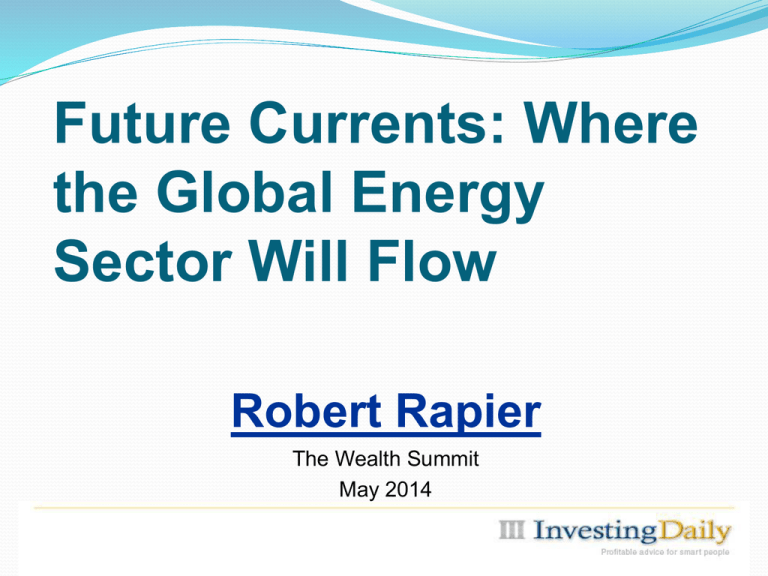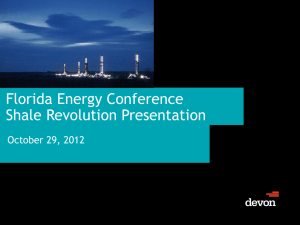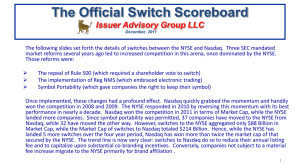Our Energy Challenges
advertisement

Future Currents: Where the Global Energy Sector Will Flow Robert Rapier The Wealth Summit May 2014 Outline Biography Philosophy on money and energy investing 2013/Q1 2014 in review Is natural gas still cheap? Shale oil continues to boom A word on coal, nuclear, and renewables A peek at my portfolio Robert Rapier Bio MS in chemical engineering from Texas A&M > 20 years in the energy business Roles in oil and natural gas production, refining, petrochemicals, renewable energy Five patents granted Worked in Germany, Scotland, and the Netherlands Based in Hawaii, but on assignment in Arizona Investor for >30 years The Hats I Wear 1. Investing Daily • Publications • The Energy Strategist/The Energy Letter • MLP Profits/MLP Investing Insider • Personal Finance 2. Merica International • Chief Technology Officer and Executive Vice President • Conduct due diligence • Develop technologies • Presently working with Advanced Green Innovations in Arizona 3. Freelance writer/commentator • • • Managing Editor, Energy Trends Insider Guest columns in Washington Post, Forbes, Wall Street Journal, The Economist TV appearances on 60 Minutes, The History Channel, and PBS Author of Power Plays • Published in 2012 • Layman’s guide to energy • Overview of energy options • History of US energy policy • Due diligence primer TES Philosophy and Portfolio Review My Money Philosophies Spend less than I earn Minimize personal debt Invest in businesses I understand Invest in profitable but out of favor businesses Understand the risk level Avoid investments that are overly dependent on government subsidies and/or mandates Identify long-term trends and invest for the long term Have an exit strategy A Few Energy Philosophies Energy is nearly as important to society as is food and water There is no economic, scalable substitute for oil Oil prices will continue to be driven by growth in developing countries A long natural gas boom is underway Coal and nuclear power face headwinds Investing in advanced biofuel companies is a good way to lose money TES 2013 in Review Purged 27 holdover companies, including royalty trusts and several foreign companies Average return of companies after selling was -5.7% Added 27 companies from across the energy spectrum Average annualized return of new buys was 28% versus 22 percent advance for the Energy Select Sector SPDR (NYSE: XLE) Kept 18 companies from previous regime Average annualized return of holdovers was 28% Full performance summary in December 27 TES story “Counting Our Blessings” Q1 2014 Report Energy Select Sector SPDR down 1% S&P 500 up 1% TES portfolios up 1.8% 12 TES “Best Buys” up 7.6% Two in the red and six returning double digits Major moves in Q1 by American Railcar (NYSE: ARII), up 52%, and First Solar (NYSE: FSLR) up 30% Current Best Buys * I own shares in this company 2014 Investment Landscape The Case for Natural Gas Global Shale Basins Shale Gas Resources North American Shale Basins Gas Production Surges Rigs Shift to More Lucrative Oil The Long Term Natural Gas Drivers LNG Exports Two dozen liquefied natural gas (LNG) export license applications under review at DOE Total capacity of all licenses applications is 35.6 billion cubic feet per day (Bcfd) This is equivalent to just over half the natural gas production in the US in 2012 Thirteen companies have applied to the Federal Energy Regulatory Commission (FERC) 2 West Coast, 2 East Coast, 9 Gulf Coast 18 Bcfd total proposed capacity Cheniere Energy Partners LP (NYSE MKT: CQP) scheduled to start exporting LNG in Q4 2015 EPA Phase-out of Mercury Mercury and Air Toxics Standards (MATS) Designed to limit emissions of mercury and other toxic substances; implementation in 2015 and 2016 Source: EIA, Annual Energy Outlook 2014 EPA Curb on Carbon Emissions Proposed limit of 1,100 lb CO2/MWh for new power plants Coal-fired power without expensive carbon sequestration unable to meet this standard Average emission rates in the US from coal-fired generation are: 2,249 lbs/MWh of carbon dioxide Average emissions rates in the US from natural gas-fired generation are: 1135 lbs/MWh of carbon dioxide EPA: “EIA projections show that natural gas is likely to be the most widely-used fossil fuel for new construction of electric generating capacity through 2020” Natural Gas Vehicles A Relevant Digression I am currently working to help commercialize a natural gas conversion kit for heavy trucking and power generation Embedded at Advanced Green Innovations in Phoenix They have developed the world's first non-invasive diesel to natural gas engine conversion kit that provides full diesel power and torque -www.zhro.com The Short Term Natural Gas Drivers Understanding Gas Inventories US natural gas consumption is seasonal During “injection season”, gas is stored under pressure in depleted oil or gas reservoirs, in natural aquifers, or in salt caverns Injection season lasts from ~April 1st to ~midNovember Inventories are then drawn down through the winter Abnormally cold or warm winters can have a lingering on natural gas prices Source: EIA, Annual Energy Outlook 2014 Natural Gas Inventories Natural Gas Inventories 1995-96 Gas prices rise 168% Natural Gas Inventories 2000-01 Gas prices rise above $10/MMBtu Natural Gas Inventories 2002-03 Gas prices rise above $15/MMBtu Natural Gas Inventories 2011-12 Gas prices fall below $2/MMBtu Natural Gas Inventories 2013-14 Largest gas withdrawal on record A Long, Cold Winter Natural gas inventories are 53 percent below normal A Long, Cold Winter Inventories not expected to recover before 2016 Prices crashed From my presentation last year: “Natural gas is cheap” Natural gas highlights Henry Hub spot price on May 31, 2013 was $4.02 per million Btu Henry Hub spot price on April 29, 2014 was $4.83 per million Btu – an increase of just over 20 percent Added Cabot Oil and Gas (NYSE: COG) to the Growth Portfolio on 3/13/13 Nation’s 12th largest gas producer Total return to date of 19.2 percent Added Chesapeake Energy (NYSE: CHK) to the Aggressive Portfolio on 5/13/13 Nation’s 2nd largest gas producer Total return to date of 43.5 percent Added Devon Energy (NYSE: DVN) to the Growth Portfolio on 9/25/13 Nation’s 4th largest gas producer Total return to date of 19.1 percent Top 20 US Gas Producers Denotes portfolio holding Disconnects Create Opportunity Cabot Oil and Gas COG drops based on short-term factors I pick up shares at $35 Natural gas takeaways Natural gas in the early stages of a long-term growth phase Short-term investors should exercise more caution, as gas producers have surged recently Downside risk short-term would be an unusually mild summer followed by a mild winter 100% of natural gas-weighted portfolio holdings have been winners to date The Shale Oil Boom Continues Global Opportunity Developing Regions Want Oil Shale Oil Resources Shale Oil Rising Top US Oil Producers Graphic source: The Economist Notable Portfolio Holdings 4 of the Top 5 US oil producers 3 of the Top 4 Bakken oil producers Continental Resources (NYSE: CLR) Whiting Petroleum (NYSE: WLL) EOG Resources (NYSE: EOG) – also top producer in Eagle Ford Formation Top producer in the Permian Basin Occidental Petroleum (NYSE: OXY) Coal and Nuclear Power Global Coal Consumption Nuclear Woes Nuclear and coal industries will be driven by growth in India and China, but will face plenty of headwinds Opportunities in Renewable Power Rapid Growth in Wind and Solar Exponential Growth Growth in Context Renewable Takeaways I believe solar power is destined to become our most important source of power Rapid capacity growth will continue in several renewable segments Opportunities exist, but most companies are richly valued and rely on government support Investors should choose entry points cautiously Notable portfolio holding is First Solar (NASDAQ: FSLR) After returning 88 percent in under seven months, we advised investors to take some profits My Portfolio My Overall Allocation Energy stocks – 29.0 percent Health care mutual funds – 20.4 percent Vanguard PRIMECAP Fund (VPMCX) – 8.2 percent Fidelity Low-Priced Stock Fund (FLPSX) – 7.3 percent Vanguard Morgan Growth Fund (VMRGX) – 6.5 percent International mutual funds – 6.7 percent Technology mutual funds – 4.9 percent 1 year portfolio return through 4/24/2014 is 31.4 percent My Energy Holdings ConocoPhillips (NYSE: COP) – 15 percent of portfolio Phillips 66 (NYSE: PSX) – 7.5 percent of portfolio Devon Energy (NYSE: DVN) – 3.2 percent of portfolio Acquired shares on 11/6/13 at an average price of $59.69; gain to date ~ 18 percent Cabot Oil and Gas (NYSE: COG) – 3.3 percent of portfolio Acquired shares on 2/28/14 at $35; gain to date ~ 12 percent 2013 Removals Petrobras (NYSE: PBR) Heavy-handed government intervention; sold for small profit Berry Petroleum (NYSE: BRY) Merger arbitrage situation; sold for small profit Westport Innovations (NASDAQ: WPRT) Lost faith in management; sold for 12 percent loss Thank You! RR Selected Publications “Biofuels” in Achieving Sustainability: Visions, Principles, and Practices. Vol. 1. published in 2014. Power Plays: Energy Options in the Age of Peak Oil published in 2012 “The Potential of Algae and Jatropha as Biofuels Sources” in Global Economic and Environmental Aspects of Biofuels published in 2012 “The Global Energy Picture” for The Economics of Alternative Energy Sources and Globalization published in 2011 “Diesel Production Processes” for Advances in Energy Research published in 2011 “Bioenergy/Biofuels” in Sustainable Development in the Forest Products Industry published in 2010 “Renewable Diesel” in Biofuels, Solar and Wind as Renewable Energy Systems: Benefits and Risks published in 2008











